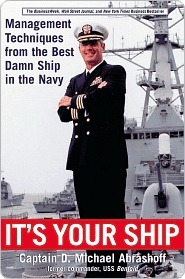More on this book
Community
Kindle Notes & Highlights
Breaking out of our stratified systems to trust the people who work for us, especially those at or near the low end of the hierarchy, was a useful, progressive change. It let us unleash people with talent and let them rise to levels that no one had expected, simply by challenging them:
you can’t “order” an outstanding performance. You have to plan, enable, nurture, and focus on it.
we delegated responsibility to people who were ready and able to accept it.
How much brainpower does the Navy—or any organization, for that matter—waste because those in charge don’t recognize the full potential hiding at the low end of the hierarchy? If we stopped pinning labels on people and stopped treating them as if they were stupid, they would perform better. Why not instead assume that everyone is inherently talented, and then spur them to live up to those expectations? Too idealistic? On the contrary, that’s exactly how Benfold became the best damn ship in the U.S. Navy. It is also the way leaders in every kind of organization can achieve new levels of
...more
One of the fringe benefits of all my one-on-one interviewing was the insight it gave me into each sailor’s life. Nothing was more useful—and moving—than learning why a kid had joined the Navy, and whether he or she had dreams or was just drifting. Most of my sailors had never had this kind of attention. No one in authority, let alone a ship captain, had ever sat down with them, discussed their goals, and helped them devise a plan to reach them.
When I took command of Benfold, I discovered that the usual policy was to have only one crew member able to perform each job: one job, one person. As a result, we were one-deep in just about every critical position. In effect, I was held hostage by the key people on the ship. If they left for any reason, I would have to scramble to get the job done, and probably not done well. It was very disconcerting.
Cross-training became our mantra. By the time we reached San Diego, we had young sailors, barely out of boot camp, doing the jobs of first-class petty officers with several hash marks, and doing them well. By grooming people to move up and accept more responsibility, cross-training raised morale. By teaching them what their shipmates did, it improved team skills and spirit. The result was a huge plus for the ship.
When I interviewed my sailors, I asked them not only how we could improve the ship’s performance, but also how we could have fun at work. The responses were amazing.
We tried to instill fun in everything we did, especially mundane, repetitive jobs such as loading food aboard the ship. Except in San Diego, where Irv Refkin’s conveyor belt came to our aid, that was a chore we did by hand, and it was hard work. We decided that music would make the job go faster. With our huge stereo system playing great tunes, it was a whole new scene. Everyone danced and boogied to the music. The officers and chiefs supervising the workforce ended up pitching in themselves. Music seemed to make even the most boring task fun—a lesson that somehow escaped the U.S. Navy.
having fun with your friends creates infinitely more social glue for any organization than stock options and bonuses will ever provide. Having fun is a notion you can apply to any workplace anywhere.
the secret of good work was good play.
Lead by example; listen aggressively; communicate purpose and meaning; create a climate of trust; look for results, not salutes; take calculated risks; go beyond standard procedure; build up your people; generate unity; and improve your people’s quality of life.
My approach to leadership on a Navy ship began as an experiment, born of necessity, but I have since found that it is far from unique. In all sorts of thriving business, the managerial role has changed from order-giver to people-developer, from authoritarian boss to talent cultivator. Nowadays, the most effective managers work hard at showing people how to find their own solutions, and then get out of their way.
let’s all stipulate the winning leader’s first principle: Optimism rules. And the corollary: Opportunities never cease.
IN OUR TIME, ORGANIZATIONS OFTEN BECOME TOO complex for their leaders to run effectively.
The price of dysfunctional leadership is, of course, a dysfunctional organization.
Once an issue becomes important to senior management, it becomes important down the chain of command. The results can be astonishing—newly loyal workers, better products, higher sales, and healthy profits. All because leaders do what they are paid to do—lead.


